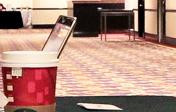Registration & fees
Workshop size is limited to 40 attendees. Break out of your resting state now!
- Students: $120
- Non-students: $200
We will serve refreshments during the coffee breaks. Lunch is on your own.
Get up to speed about the fundamental principles of full brain network modeling using the open-source neuroinformatics platform The Virtual Brain (TVB).
TVB enables biologically realistic modeling of network dynamics using Connectome-based approaches across different brain scales.
Generate macroscopic neuroimaging signals including fMRI, intracranial and stereotactic EEG, surface EEG and MEG for single subjects.
Researchers from different backgrounds can benefit from an integrative software platform including a supporting framework for data management (generation, organization, storage, integration and sharing) and a simulation core written in Python.
The architecture of TVB supports interaction with MATLAB packages, e.g. the well-known Brain Connectivity Toolbox.
Simulated brains. Real memories.
After the workshop you should have a basic picture of how these models are built, how they work, and what biological properties of a neural system they represent. In addition, we will highlight several research topics that can be explored using this tool.
For the brave ones who like diving directly into the code, we expect you to know some Python, MATLAB, Octave, or whatever programming language you like the most.
The workshop is organized with interleaved oral presentation and hands-on sessions. Attendants will have the time to ask questions.
The hands-on sessions will let you immediately apply the concepts from the lectures to your simulations in TVB.
Visit Node#2 and SfN 2014
TVB:Node#2 will take shortly before the annual meeting of SfN 2014, also in Washington, USA:
Node#2 is an officially registered satellite event of SfN. The TVB team will also exhibit their latest software version at their own booth to more than 30,000 visitors from more than 80 countries.
Prepare your gear
To get the most out of this workshop as an attendee, you might want to get a head-start by preparing your gear before you arrive:
- Download and install the latest stable TVB package.
- Test it in its current form to make sure it's compatible with your computing environment.
- Familiarize yourself with the basics by browsing through the included manual (TVB-Distribution/docs/UserManual.pdf).
Meet the TVB team
Apart from learning together, you can meet and talk to a good part of The Virtual Brain's core team, covering a broad range of topics from cutting-edge neuroscience research to advanced software development.
- Tanya Brown, Toronto
- Michael Burgstahler, Stuttgart
- Lia Domide, Cluj-Napoca
- Viktor Jirsa, Marseille
- Randy McIntosh, Toronto
- Jochen Mersmann, Stuttgart
- Petra Ritter, Berlin
- Paula Sanz-Leon, Marseille
- Ana Solodkin, San Diego
- Students from active research projects
Program: Morning Session
09:00 - 09:15 am
Introduction to workshop & caffeine intake
09:15 - 10:45 am
A generative model of the brain: Describing the building blocks of a brain network model
Learn about the basic principles and assumptions underlying a brain network model, recent studies using different local models, cortical connectivity and dynamical units. Understand how to approximate neural fields.
10:45 - 11:00 am
Coffee break
11:00 - 12:30 am
Interacting with TVB
Presents available tools of TVB project, as well as details of the architecture underneath. At times, you will be advised to follow the presenter with your own laptop, learning about the web UI as well as the console interface.
12:30 - 02:00 pm
Lunch break
Program: Afternoon Session
02:00 - 02:45 pm
How to obtain a TVB friendly dataset
Understand how a complete TVB dataset works, which neuroimaging data formats can be imported and how to set up data-obtaining pipelines extracting subject-specific structural data.
02:45 - 03:30 pm
Hands-on: Modeling brain networks at rest
See how TVB can model resting states and explore the dynamics of a resting brain you've built by yourself
03:30 - 04:00 pm
Coffee break
04:00 - 04:40 pm
Hands-on: Modeling the impact of structural lesions
Follow the design of a simulation protocol where the Connectome is the "parameter" to be explored. Learn about the effects of conduction speed and time delays to reveal the space-time structure of the connectivity matrix.
04:40 - 05:10 pm
Hands-on: Modeling epilepsy using TVB
Build a working example of an epileptic brain on your own laptop.
Closing remarks

Location
View on mapRenaissance Washington, DC Downtown Hotel
999 Ninth Street NW
Congressional Ballroom C
Washington, District of Columbia 20001, USA
Organizers
This workshop is organized and hosted by the TVB team.
If you have any organizational question, please don't hesitate to send an email to our program manager, Tanya Brown.
Download info
We prepared some concise PDF files to assist your visit and to help spread the word:






